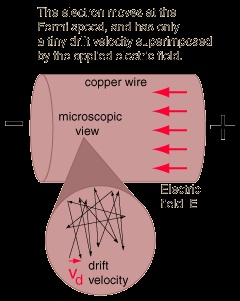Let us consider a conductor of length L having cross-sectional area A. Let i is the current passing through through the conductor and R is the resistance of the conductor and V is the potential difference applied across the two ends of the conductor then by ohm's law :-
V=iR ........(1)
_fa_rszd.jpg)
Since the resistance of a conductor with resistivity r, length L and area A is given by :-
R=rL/A
Putting above value of R in equation (1) :-
V=irL/A .........(2)
If E is the electric field intensity across the ends of conductor and V is the potential difference then the relation between field and potential difference is
V=EL .........(3)
Comparing equation (2) and equation (3) :-
EL=irL/A
E=ir/A
E=(i/A)r .........(4)
Since by definition of current density J :-
J=i/A
_fa_rszd.jpg)
Putting this value in equation (4) :-
E=Jr
Since r is resistivity and conductivity c is the the reciprocal of resistivity i.e
c=1/r
=> r=1/c
Hence;
E=J/c
=> J=cE .........(5)

Equation (5) is the Microscopic Form of Ohm's Law in terms of conductivity, electric field intensity and current density.
Conductivity, electric field intensity and current density are microscopic quantities and the reason for the name of equation (5) is that it relates microscopic quantities. Microscopic quantities of materials depend on certain properties of the material at a certain point inside the material and is independent pf overall properties of the material. Resistivity is also a microscopic quantity.



